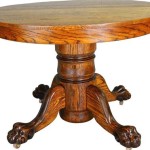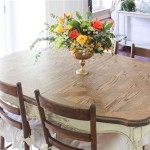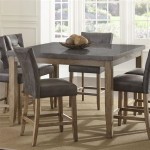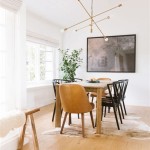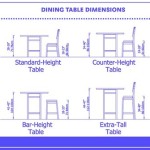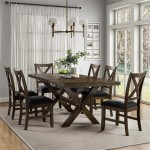Folding Dining Tables: A Practical Solution for Two
In contemporary living spaces, optimizing functionality without sacrificing aesthetic appeal is a paramount concern. Folding dining tables, particularly those designed for two individuals, represent a compelling solution for maximizing space and adapting to varying lifestyle needs. These tables offer the convenience of a dedicated dining area when required, while seamlessly folding away to reclaim valuable floor space when not in use. This article explores the diverse aspects of folding dining tables for two, encompassing their design considerations, material choices, functionality, and suitability within different living environments.
Space Optimization and Adaptability
The primary advantage of a folding dining table for two lies in its space-saving design. Compact apartments, studios, or smaller homes often lack the square footage required for a permanent dining set. A folding table addresses this challenge by providing a surface for meals that can be readily stowed when not needed. This adaptability is particularly beneficial in multi-functional rooms, such as living rooms or home offices, where the dining area needs to transform effortlessly according to the time of day or activity.
Folding mechanisms vary, influencing the table's overall footprint and ease of storage. Some tables feature a drop-leaf design, where one or both sides of the tabletop fold down, reducing the surface area by half or more. Others employ a butterfly leaf mechanism, where the leaf folds and stores internally. Wall-mounted folding tables provide an even more space-efficient option, folding flat against the wall when not in use, making them ideal for extremely limited spaces.
Beyond space saving, folding dining tables offer adaptability to accommodate occasional guests. While designed for two, some models can be extended or partially unfolded to provide additional seating for a small gathering. This flexibility makes them suitable for individuals or couples who occasionally entertain but do not require a large dining table on a daily basis.
Material Considerations and Design Aesthetics
The materials used in the construction of a folding dining table significantly impact its durability, aesthetics, and overall lifespan. Common material choices include solid wood, engineered wood products (such as MDF or plywood), metal, and glass. Each material offers distinct advantages and disadvantages in terms of cost, maintenance, and visual appeal.
Solid wood tables, such as those crafted from oak, maple, or walnut, offer superior durability and a timeless aesthetic. They are resistant to scratches and dents, and can be refinished to maintain their appearance over time. However, solid wood tables tend to be more expensive and may require more careful maintenance to prevent warping or cracking due to changes in humidity.
Engineered wood products, such as MDF and plywood, provide a more affordable alternative to solid wood. These materials offer good stability and are less susceptible to warping. They are often used in conjunction with wood veneers or laminate finishes to achieve a specific aesthetic. While engineered wood products are generally durable, they are typically less resistant to damage than solid wood and may not be as easily repairable.
Metal frames provide structural support and can add a modern or industrial aesthetic to the table. Metal is durable and easy to clean, making it a practical choice for a dining table. However, metal can be prone to scratching and may feel cold to the touch. Additionally, metal tables may require more attention to detail in their construction to avoid sharp edges or instability.
Glass tabletops can create a sleek and contemporary look. Glass is easy to clean and resistant to stains. However, glass is fragile and can be easily scratched or broken. Glass-topped tables typically require careful handling and may not be suitable for households with young children.
The design aesthetics of a folding dining table should complement the existing décor of the room. Tables are available in a wide range of styles, from traditional to modern, and can be customized with various finishes, colors, and hardware options. Considerations should be given to the shape of the tabletop, the style of the legs, and the overall proportions of the table to ensure that it integrates seamlessly into the space.
Functionality and Practical Considerations
Beyond its space-saving design and material choices, the functionality of a folding dining table is crucial for its usability and convenience. Several practical considerations should be taken into account when selecting a table, including the ease of folding and unfolding, the stability of the table when in use, and the storage options when folded.
The folding mechanism should be smooth and easy to operate, allowing for quick transitions between the folded and unfolded states. Tables with stiff or cumbersome folding mechanisms can be frustrating to use and may discourage frequent use. Ideally, the mechanism should be intuitive and require minimal effort to operate.
The stability of the table when in use is paramount. A wobbly or unstable table can be dangerous and detract from the dining experience. The table should be designed with a sturdy frame and robust folding mechanism to ensure that it remains stable even when fully loaded with plates, cutlery, and drinks. Look for features such as locking mechanisms or adjustable feet to enhance stability.
Storage options should be considered based on the available space and the intended frequency of use. Some folding tables are designed to be stored flat against a wall, while others can be folded and stored in a closet or corner. Wall-mounted tables offer the most space-efficient storage option, but may require professional installation to ensure that they are securely mounted. Tables that can be folded and stored in a closet provide more flexibility in terms of placement, but may require more effort to move and store.
The height of the table should be appropriate for comfortable dining. Standard dining table height is typically around 29-30 inches. The chairs selected should be compatible with the table height to ensure that diners can sit comfortably and reach their plates without straining. Consider the legroom available under the table to ensure that there is sufficient space for legs to move freely.
Finally, consider the maintenance requirements of the table. Tables made from durable materials, such as solid wood or metal, are generally easier to clean and maintain. Tables with intricate designs or delicate finishes may require more careful cleaning and maintenance to preserve their appearance. Choose a table that is easy to clean and maintain based on your lifestyle and cleaning habits.
By carefully considering these design, material, and functional aspects, individuals can select a folding dining table for two that seamlessly integrates into their living space, providing a practical and aesthetically pleasing solution for dining in smaller environments.

Dinaza 55 1 In Rectangle Black Marble Wood Folding Dining Table Drop Leaf With 2 Tier Racks Wheels Seats 6 Poa7039024 The Home

Spanspace Folding Dining Table Drop Leaf With 6 Wheels And 2 Layer Storage Shelf Space Saving For Small Spaces

Folding Dining Table Drop Leaf With 6 Wheels And 2 Layer Storage Shelf Space Saving For Small Spaces

Folding Dining Table Drop Leaf With 6 Wheels And 2 Layer Storage Shelf Space Saving For Small Spaces

Rectangle Extendable Dining Table For 2 8 People Modern 16 73 White Blue Yellow

Folding Dining Table With 6 Wheels Kitchen 2 Layer Storage Shelf Space Saving For Small Apartment Rustic Brown And Black

Dinaza 55 1 In Rectangle White Marble Wood Folding Dining Table Drop Leaf With 2 Tier Racks Wheels Seats 6 Poa6809144 The Home

Kitchen Table Set For 2 Expandable Dining With Upholstered Folding Chairs

Homcom Folding Dining Table For 2 To 4 People Drop Leaf Kitchen Small Spaces Rustic Brown

Tavern Rectangular Fixed Folding Dining Table


